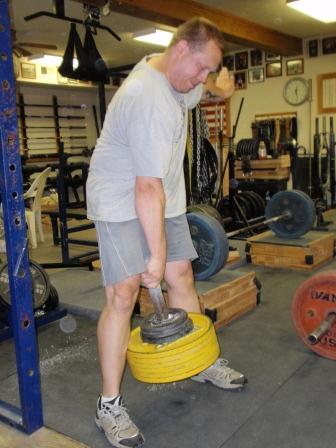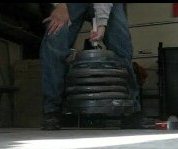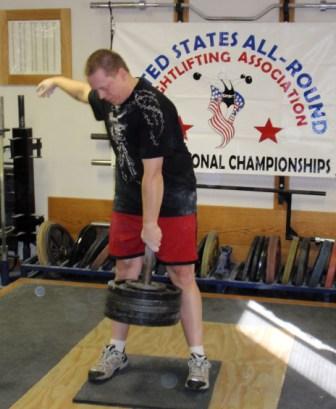2″ Vertical Bar Training Tips
by Ben Edwards

This is Ben's record lift of 251 pounds in the One Hand Vertical Bar Deadlift done at the 2011 Dino Days Record Day last weekend. This is the new ALL TIME Vertical Bar Deadlift record in the USAWA, breaking the record held of 250 pounds by Andrew Durniat. At this same record day, Ben also did a 240 pound LEFT HANDED Vertical Bar Deadlift, which is the highest left handed mark as well! (photo and caption courtesy of webmaster)
I’m going to share a few tips that have helped me push my record in the 2″ vertical bar significantly higher in my weight class over the past few years.
The key to this lift is obviously grip strength. But a sometimes overlooked factor that makes a big difference in the amount of weight that can be lifted is the grip taken on the vertical bar at the start of the lift. An over grip is the most efficient grip when performing the USAWA version of the 2” vertical bar. That distinction is made because in other grip contests that I compete in – those that are not USAWA contests – a supinated grip is far more efficient in lifting maximal poundages for most people. USAWA rules dictate that the weights attached to the vertical bar will be lifted to the required height and then held motionless until the judge gives the down command. When a supinated grip is used the weights will rotate quite a bit and tend to spin right out of the hand essentially. The supinated grip is best used to lift heavy weights over short distances – 2” is the minimum height needed to be a contest-legal lift in most non-USAWA grip contests. An over grip prevents the rotation of the plates and is therefore much more efficient than lifting the weight and then expending energy trying to stop the rotation of the weights before getting the judge’s down signal. A handshake grip will involve less rotation of the weights than the supinated grip. But it isn’t as efficient as the over grip in preventing rotation of the weights.
One simple rule I adhere to in my training is to attempt to do every lift in contest-legal form. If I fail to perform the lift in contest-legal form I note that in my training log and set my goal for the next workout a little higher than what I achieved in the last workout. I videotape all of my near-max attempts in training. While resting for the next set – I review the video to make sure that I performed the lift in contest-legal form. I also critique my form to make sure that I’m not wasting energy stopping the rotation of the plates (using an over grip usually means that I don’t worry about rotation of the plates) and that I’m pulling the vertical bar in the most direct up-and-down motion as possible.
So to summarize:
- Use the over grip exclusively in training.
-It is the most efficient grip for the USAWA 2” vertical bar rules.
- Perform each lift in contest-legal form.
-That way when you’re attempting to break a record you won’t have any accidental lapses in form – due to training with a loose style that doesn’t exactly match the contest-legal performance of the lift.
- Videotape each near-max attempt in training.
-Review the video to ensure that all of your near-max lifts are performed in contest-legal form so that you won’t have any surprises in a contest setting.
This was a 387 pound 1” vertical bar training lift (December of 2006) that was pulled a little higher than the (non-USAWA) standard grip contest minimum height requirement of 2 inches. What the photo doesn’t show is that the weights were rotating from the time they left the floor until they touched down again. Standard grip contests don’t require the rotation of the weights to be stopped – or a judge’s down signal. These more relaxed rules allow significantly more weight to be lifted compared to the strict USAWA rules.
This was my event-winning 2” vertical bar lift from the 2011 USAWA National Grip Championships held at the Dino Gym in February. You can clearly see the over grip being put to work. It allowed me to pull the weights straight up – without worrying about having to stop the rotation of the plates – and then lower the weights straight down as quickly as possible after receiving the judge’s down signal.
Minimizing the time spent holding the weight is of paramount importance in maximizing your poundage lifted.

